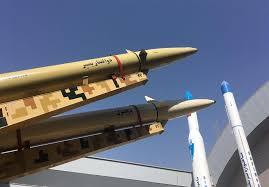
Iran’s defense minister, General Aziz Nasirzadeh, told the state broadcaster that the missile has been enhanced both in terms of guidance and maneuverability, compared to previous missiles.
He also pointed out that Qassem Basir will be immune to the American THAAD and Patriot air defense systems, as well as the Israeli regime's layered Arrow systems.
Iranian TV aired related footage of a ballistic test, reportedly conducted on April 17, showing Qassem Basir’s launch and its precise impact on a designated target in a natural setting.
Nasirzadeh noted that during testing, intense electronic interference was applied against the missile, yet it remained unaffected.
The missile reportedly has higher maneuverability, gained from experience during last year's two retaliatory operations known as True Promise 1 and 2 against the Zionist regime.
Haj Qassem is a two-stage tactical solid-fuel quasi-ballistic missile, unveiled in August 2020 and named after the martyred Iranian commander Qassem Soleimani.
The missile has a total mass of 7 tons, a warhead weighing 500 kilograms, and a length of 11 meters. Its atmospheric entry speed is Mach 11, and its impact speed is Mach 5, placing it in the hypersonic domain.
Haj Qassem's reported range is 1,400 kilometers, and at the time of its unveiling, it was stated that the missile was designed with the potential to extend its range to 1,800 kilometers.
In 2023, during a visit by the late President Ebrahim Raeisi to the Defense Achievements Exhibition, a new capability of the Haj Qassem missile was demonstrated, significantly reducing its preparation and launch time compared to previous systems.
This improvement stemmed from modifications to the missile's platform structure, allowing for much faster readiness and launch than earlier models.
Experts believe the missile system employs Dynamic Reference Unit (DRU) technology, which provides real-time, high-precision orientation data, such as pitch, roll, and yaw, by integrating accelerometers, gyroscopes, and sometimes magnetometers.
With the aid of this system, a transporter erector launcher (TEL) can initiate firing immediately after deployment and erection, then quickly fold and vacate the launch site.
This technology has also been incorporated into the Kheibar Shekan and Fateh missile systems and, according to Brigadier General Amir Ali Hajizadeh, reduces preparation time to one-sixth compared to other missiles.
Based on statements from military officials and launch footage, Qassem Basir shares many similarities with Haj Qassem in terms of dimensions and capabilities, and uses the same launch platform.
Both missiles feature eight stabilization fins at the aft end and lack thrust vector control, which is present in other Iranian missile systems, but still achieve sufficient maneuverability through aerodynamic control surfaces and trajectory adjustments in the terminal phase.
There are two differences between Qassem Basir and Haj Qassem regarding warhead upgrades—specifically, the guidance system and maneuverability.
Iranian ballistic missiles, including Haj Qassem, mainly use a combination of the Global Positioning System (GPS) and an inertial navigation system (INS).
With these two capabilities, a missile flies based on GPS data in the first to middle phases of its trajectory and uses INS guidance in the final phase.
The reason for this is that GPS can be disrupted by electronic warfare (EW) activities, and the enemy will certainly use various EW methods to disrupt missile guidance in order to deflect ballistic missiles and cause errors in their targeting.
On the other hand, the INS uses several gyroscopes and accelerometers responsible for guiding the missile toward the target by calculating angular velocity and preventing the missile from deviating.
However, since the INS-guided missile corrects its course based on physical and atmospheric variables, as well as the high speed of the missile in the final phase of its movement, the missile's accuracy decreases compared to GPS guidance.
Experience with anti-Israeli operations, specifically the need for high precision for hitting targets such as hangars and, at the same time, immunity to electronic jamming, resulted in the introduction of optical guidance for the Qassem Basir missile.
Optical guidance, especially thermal imaging cameras, not only significantly increases the accuracy of the hit, but is also resistant to electronic warfare or any external jamming.
One of the limitations of this guidance method is the reduction in the missile's range, which is also the reason for the reduction in the range of the Qassem Basir missile compared to the Haj Qassem missile.
Despite this reduction of 200 kilometers, the range of the Qassem Basir missile is sufficient to reach the occupied Palestinian territories.
It should be noted that optical guidance was used in various earlier Iranian short-range ballistic missiles, but their range was mostly up to 300 or 500 kilometers, significantly less than Qassem Basir.
With these guidance capabilities, the new missile is capable of hitting even the most selective targets, such as hangar entrances or even moving ships at sea.
A released video of a Qassem Basir missile test demonstrated that a marked square target was hit in the very center, suggesting that accuracy is measured in decimeters, not meters.
Another feature that has been implemented in the Qasem Basir missile is its warhead maneuverability, important as all the world's air defense systems are defenseless against missiles that have the ability to change course at supersonic or hypersonic speeds.
Source: PressTV